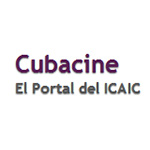 “Nuestro objetivo final es nada menos que lograr la integración del cine latinoamericano.
Así de simple, y así de desmesurado”.
“Nuestro objetivo final es nada menos que lograr la integración del cine latinoamericano.
Así de simple, y así de desmesurado”.
Gabriel García Márquez
Presidente (1927-2014)

CRITICA

-
Sobre El Coraje del Pueblo, de Jorge SanjinesPor Maria Victoria Romero
Por regla, ningún signo es en tanto no sea otro, esta negatividad se manifiesta en todo sistema de comunicación, esto incluye al cine; lo que quiero decir es que El Coraje del Pueblo es una película porque no es otra, pero esto no se debe a la regla de negatividad, sino a una elección del autor.
“Sinopsis: Jorge Sanjinés relata la masacre de la noche de San Juan durante el gobierno de Barrientos. Los personajes relatan sus vivencias, relacionadas con ese trágico acontecimiento, llevado a cabo por las fuerza represoras del general Barrientos, bajo el pretexto de sofocar un movimiento sindical subversivo vinculado a la guerrilla comandada por el 'Che' Guevara, en Bolivia”
He aquí una sinopsis de la película que comunica sencillamente y en pocas palabras de que trata El Coraje del Pueblo (1971). La impresión que particularmente me generó al leerla es que quien vio esta película cometió el error de tomarla solamente como un suceso artístico, y puntualmente cinematográfico. Creo que esta película no puede, ni debe tomarse como un hecho aislado o meramente artístico.
El Coraje del Pueblo, comienza contando sobre la vida del trabajador minero boliviano, y cómo la conjunción del poder capitalista esta siempre atenta al exterminio de quien proponga cortar las cadenas de opresión. La tríada asesina da cuenta de cuál es la base del capitalismo: aquí aparecen, en todos los casos de matanzas multitudinarias, tres figuras que representan al dueño de alguna empresa, al gobierno de turno y a algún representante de las fuerzas represivas. Es muy interesante la apuesta a un diálogo cinematográfico dialéctico, ya que en la primera parte del film mediante un montaje fotográfico se muestran imágenes de otras seis represiones ocurridas además de la Masacre de San Juan, que es el hecho narrado en dicho film.
El hecho cotidiano, es decir, el aspecto “real” deja camino al hecho narrado. Que el film este protagonizado por aquellas personas que vivieron ese 24 de junio, es una muestra más de lo que más arriba destaca la intención del director: su compromiso de lucha. No puedo dejar de destacar el compromiso de quienes de la misma manera formaron parte de este proceso, quienes dan vida a los personajes: hombres y mujeres que encarnaron a ellos mismos o a sus compañeros asesinados, y que también son ejemplo de su deber. Trabajadores que quieren (conjuntamente al director) mostrar cual es el motivo de su explotación, cómo por acción u omisión quien no pone el cuerpo también es cómplice de esta injusticia. Dando cuenta que los acontecimientos que se muestran son procesos.
Una escena llamó particularmente mi atención, la que muestra a un joven victima de la represión del 24 de junio, imposibilitado de caminar, mientras una voz en off cuenta lo que le pasó: el hombre esta sentado en su silla de ruedas, con un pequeño telar entre sus manos, realizando alguna artesanía, cuando termina el relato de la voz en off, éste mira a la cámara. Esto podría interpretarse como mensaje al espectador, a aquel otro que mira, proponiéndole dejar de lado la mirada pasiva y reconocerse como parte activa de cada uno de los procesos sociales, llamándolo a despertar y accionar.
La apuesta a un nuevo lenguaje cinematográfico, como la de Sanjinés en El coraje del pueblo, en el que la dialéctica opera desnaturalizando los hechos “cotidianos”, es el reto que debe exigir quien apuesta a un cine útil, con una finalidad concreta que no se agote en el entretenimiento.
 About El Coraje del Pueblo
About El Coraje del Pueblo
By Maria Victoria Romero
As a rule, no sign is a sign, as long as it is not other, this negativism is manifested in all communication systems, this includes the cinema; what I mean is that El Coraje del Pueblo is a movie because it is not other, but this is not due to the negativism rule, but because of the author's choice.
"Synopsis: Jorge Sanjinés relates the massacre of San Juan's night during the government of Barrientos. The characters relate their experiences, related with that tragic event, carried out by the repressive forces of the general Barrientos, under the pretext of suffocating a subversive union movement linked to the guerrilla commanded by 'Che' Guevara in Bolivia."
There is a synopsis of the movie that communicates simply and in few words what El Coraje del Pueblo (1971) is about. The impression that generated to me when I read this synopsis is that who saw this movie commit the mistake of considering it only as an artistic fact, and a punctual film event. I believe that this movie could not, and neither should be considered as an isolated or merely artistic fact.
El Coraje del Pueblo, begins telling about the lives of Bolivian mining workers, and how the conjunction of the capitalist power is always attentive to the extermination of those who intends to cut the chains of oppression. The murderous triad accounts which are the base of the capitalism: Here it appears, in all the cases of mass slaughters, three figures that represent the owner of some company, the government of the moment and a representative of the repressive forces. It is very interesting the commitment to a dialectical film dialogue, since in the first part of the film, by means of a photographic montage are shown images of other six repression activities in addition to the San Juan's Massacre that is the fact narrated in this film.
The daily fact, i.e. the "real" fact gives way to the narrated fact. The fact that the film is played by those people that experience this June 24th evidence that the above mentioned highlights the director's intention: his commitment to the struggle. I can not avoid highlighting the commitment of those who in the same way were part of this process, who bring life to the characters: men and women that represented themselves or their murdered partners, and who are also an example of duty; workers that want (together with the director) to show which is the reason of their exploitation, as well as, for action or omission, who does not commit his body is also accomplice of this injustice and accounting that the events that are shown are processes.
A scene got my attention particularly, the one that shows a young victim of the repression of June 24th, unable to walk, while a voice over tells what happened: the man is seated on his wheelchair, with a small loom in his hands, making some craftwork, when the voice over finishes the story, he looks to the camera. This could be interpreted as a message to the spectator, to that other one that looks, intending him/her to leave aside the passive look and be recognized like active part of each one of the social processes, calling him/her to wake up and act.
The commitment to a new film language, as that of Sanjinés in El Coraje del Pueblo, in which the dialectic operates denaturalizing the "daily" facts, is the challenge that should demand the ones committed to a useful cinema, with a concrete purpose that is not exhausted in mere entertainment.
(Fuente: tierraentrance-miradas)

Copyright © 2026 Fundación del Nuevo Cine Latinoamericano. Todos los derechos reservados.
©Bootstrap, Copyright 2013 Twitter, Inc under the
Apache 2.0 license.















